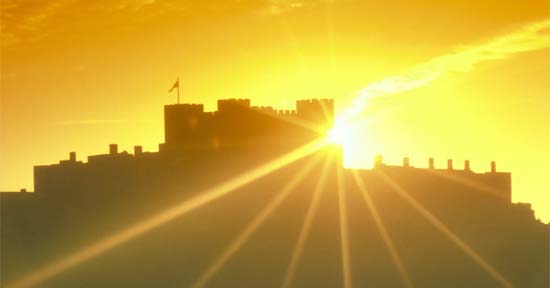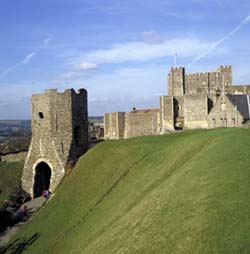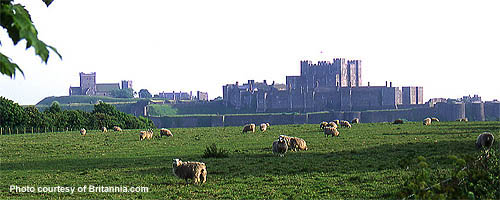Dover Castle: Fortress on the Front Line
by Julia Hickey
As Henry II's great keep rises on the skyline it is evident that for one monarch at least size mattered. Indeed, the current keep encircled by a double ring of stout battlements, was the first concentric fortification in Western Europe.

The site of the Iron Age hill fort that still determines the shape of the castle complex was well chosen. Crouched menacingly on top of the famous White Cliffs, overlooking the Straits of Dover, just twenty-six miles from the French coast Dover Castle has guarded England's shores for more than nine hundred years. However, this site has never been unimportant. The lighthouse built by the Romans to guide ships across the Channel and into safe harbour still stands, as does the church that served the Saxon fortified town that stood here before William the Conqueror set about stamping his authority on the English people and their landscape in 1066.
The tour of the massive keep begins with a walk from the car park through the jaws of two imposing gateways into the inner bailey. At 83ft high, the keep is a formidable fortress. Climb the outer staircase before being led through a potentially lethal series of small chambers, pass under a vicious looking portcullis, up more stairs and cross the drawbridge pit. It is not hard to imagine valiant knights swashing their buckles in some desperate battle to the death.
 Visitors are drawn upwards. Climb spiralling staircases, explore dark passages and hidden galleries, pause to trace intricately carved emblems, peer up at vaulted ceilings and down into the depths of medieval garderobes. Entering the echoing Great Chamber and Great Hall on the second floor is to tread in the footsteps of Henry II, Henry III and King John of Magna Carta fame. See where Edward IV, father of the two princes murdered by their uncle in the Tower of London, made the keep more comfortable. Experience the castle during the time of Henry VIII on one of his many progresses. Pause to think of Ann of Cleves, the ugly bride who escaped with her head, staying in the royal apartments on her arrival in England or of Henrietta Maria who stayed here on her way to marry the unfortunate Charles I.
Visitors are drawn upwards. Climb spiralling staircases, explore dark passages and hidden galleries, pause to trace intricately carved emblems, peer up at vaulted ceilings and down into the depths of medieval garderobes. Entering the echoing Great Chamber and Great Hall on the second floor is to tread in the footsteps of Henry II, Henry III and King John of Magna Carta fame. See where Edward IV, father of the two princes murdered by their uncle in the Tower of London, made the keep more comfortable. Experience the castle during the time of Henry VIII on one of his many progresses. Pause to think of Ann of Cleves, the ugly bride who escaped with her head, staying in the royal apartments on her arrival in England or of Henrietta Maria who stayed here on her way to marry the unfortunate Charles I.
One of the doorways in the great Chamber leads up a narrow staircase to the roof. The climb is worth it. Dover, sitting between two green hills seems like a toy town. On a clear day you can see the coast of France and there are always ferries and hovercraft to be seen chugging into and out of the harbour. There is also a wonderful seagull's eye view of the castle grounds and other fortifications from between the crenulations. Coming down, out of the gusting wind, the tour winds down through the basement of the keep. There is an exhibition here now but until as recently as 1940, it stored the provisions and arms necessary to withstand a siege.
There is nothing cosy about Dover Keep. It is a stone statement of power and defiance. At times there is almost too much to take in. Fortunately, the complex offers two restaurants where visitors can go to recharge their batteries: the NAAFI restaurant, themed on the Second World War, which serves hot meals; and a cafeteria serving light refreshments in the Keep Yard.
If you don't fancy a good strong brew of English tea what about a bracing walk along the grassy battlements? Explore towers, moats, an arsenal, artillery outworks and gun emplacements created when England expected Napoleon's invading armies any day. It is easy as you gaze down the length of a cannon's muzzle to conjure the square-topped rigging of Boney's invading fleet. A few paces more and a hundred and fifty years later operate an ack-ack gun or stand where Vice Admiral Ramsay viewed the harbour and Channel during the dark days of Dunkirk. A statue of the Vice Admiral looking out to sea was unveiled in 2000.

The Secret Tunnels of Hellfire Corner
A little way from here Dover Castle's story goes underground to Hellfire Corner and the secret wartime tunnels. Not that tunnelling was a new idea conceived to orchestrate the campaign against the axis powers. There have been tunnels under Castle Hill since 1216. The medieval tunnels are at the northern edge of the castle and were mined following a lengthy French siege. The idea was to enable English soldiers to move undetected or to launch themselves on the enemy in surprise attacks. Today the walls of these tunnels are covered with black mould and in wet weather run with damp. The castle may not have dungeons but these tunnels with their iron-studded doors and gothic arches are dark and atmospheric.
The medieval tunnels were extended during the Napoleonic Wars in the eighteenth century. Seven parallel tunnels were blasted out of the chalk. A barracks for more than 2000 men was created; giving Dover Castle the only underground barracks ever built in Great Britain. Later these tunnels were used by the Coast Blockade Service to combat smuggling gangs but by the twentieth century they had been largely abandoned.
The tunnels and Hellfire Corner is what makes Dover Castle truly unique. Take advantage of one of the timed tours led by friendly and informative guides that take visitors down into Casemate, the bombproof headquarters of the Royal Navy's Dover Command. There is a short film before beginning the journey back into the dark days of war torn Europe. See the hospital on Annexe level above Casemate, some of the quarters that housed 10,500 troops, the canteen, the military telephone exchange, switchboards and transmitters. The plotting table in the operations room is the original one as is the clock in the Anti-Aircrafts Operation Room. Listen to the sound of an air raid and the voices of the men and women going about their duty deep inside the cliffs as Operation Dynamo swung into action to save what remained of the BEF stranded on the beaches of Dunkirk.
Hellfire Corner is about the epic struggle of a nation to survive, the genius of great men and about the men and women who served here: ordinary heroes. The name for Operation Dynamo came from a secret conversation between Ramsey and Winston Churchill held in the Dynamo room where no one could hear them. The walls of the tunnels leading to the Dynamo Room are lined with the graffiti of the people who lived and worked in the eerie light of the tunnels. There are thousands of crosses and vertical lines amongst the initials and dates. Soldiers carved a vertical line before they were sent into the battlefront. Men who returned made the horizontal additions that form the crosses. Perhaps the ghost who walks the corridors is a man who didn't make it home.
Time to allow for a visit to Dover Castle: English Heritage suggests four hours is sufficient but for a more leisurely experience with pauses for refreshment allow longer.
Sidebar: If there's time, why not visit Dover Museum and experience life for the inhabitants of Dover during the blitz. Take a stroll on the seafront. A statue marks the point where all cross channel swims begin.
More Information:
We regret that we no longer have the resources to maintain up-to-date links and/or hours and pricing details for the various sites and attractions listed on this website. For more information about the location(s) listed above, please use your favorite search engine or visit Wikipedia.
Julia Hickey is passionate about England's heritage and particularly that of Cumbria, where her husband comes from. In between dragging her family around the country to a variety of historic monuments, she works part-time as a senior lecturer at Sheffield Hallam University. She spends the rest of her week writing. In her spare time, she enjoys walking, dabbling in family history, cross-stitch, tapestry and photography.
Article © 2006 Julia Hickey
Photos 1 & 2 courtesy of Britainonview.com; Photo 3 courtesy of Britannia.com
| 